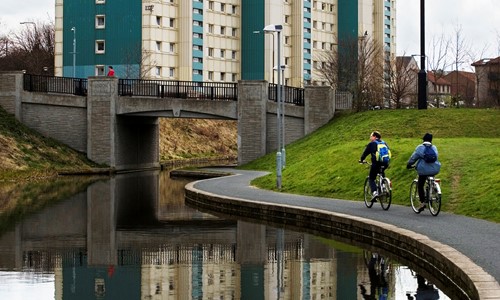
Overview
Transport Scotland aims to get more people making active travel choices for short everyday journeys wherever possible, to improve health and the environment. The long term vision sets out how Scotland will look in 2030 if this is achieved. Linked to the long term vision are the National Walking Strategy and the newly published Active Travel Task Force report which makes recommendations for overcoming barriers to the delivery of innovative and new walking and cycling infrastructure.
Transport Scotland grant funds organisations for both building infrastructure and behaviour change interventions (such as mapping, signage and information on routes, cycle training, cycle loan schemes, led walks), to encourage more people to walk, wheel and cycle more often.
The Scottish Government has also confirmed in the Programme for Government that it will maintain record levels of funding for Active Travel for the duration of this Parliament. This funding will also help to deliver our commitment to the shared vision.
It goes without saying that walking and cycling benefits the individual with not just physical health benefits, but benefits for mental health, the environment and keeping people's transport costs down. Transport Scotland is committed to making it easier for everyone to incorporate active travel choices into their daily routines.
Get active
Transport Scotland aims to get more people making active travel choices for short everyday journeys wherever possible, to improve health and the environment. The long term vision sets out how Scotland will look in 2030 if this is achieved. Linked to the long term vision are the National Walking Strategy and Cycling Action Plan for Scotland 2017-2020
Transport Scotland grant funds organisations for both building infrastructure and behaviour change interventions (such as mapping, signage and information on routes, cycle training, cycle loan schemes, led walks), to encourage more people to walk and cycle more often. These include Paths for All, Cycling Scotland, Sustrans and Local Authorities across Scotland.
The Scottish Government has also confirmed in the Programme for Government that it will maintain record levels of funding for Active Travel for the duration of this Parliament. This funding will also help to deliver our commitment to the shared vision as reiterated in the Cycling Action Plan for Scotland 2017-2020 that by 2020 10% of everyday journeys will be by bike.
It goes without saying that walking, wheeling and cycling benefits the individual with not just physical health benefits, but benefits for mental health, the environment and keeping people's transport costs down. Transport Scotland is committed to making it easier for everyone to incorporate active travel choices into their daily routines.
The benefits
Transport Scotland is committed to increasing cycling levels, both for everyday travel and for leisure, because it brings significant benefits to all involved.
Approximately 34% of all car journeys in Scotland are less than two miles in length and could be covered by bicycle or on foot instead. The benefits of more people walking, wheeling and cycling include:
- easing congestion
- reducing noise pollution
- cutting exhaust emissions
- improving health
- giving us more time to enjoy our urban spaces
- saving money
For businesses and other organisations, developing a walking, wheeling and cycling culture can help:
- lower organisational transport costs
- reduce the need for expensive car parking spaces increase productivity through improved staff well-being
- demonstrate a commitment to protecting the environment
- meet criteria for accreditation schemes such as the Healthy Working Lives Award and the Cycle Friendly Employer Award
What we do
Support cycling organisations and projects
We provide funding to the following partners to encourage walking, wheeling and cycling in Scotland:
- Sustrans
- Cycling Scotland
- Living Streets
- Energy Saving Trust
- The Bike Station
- Paths for All
- Forth Environment
Alongside helping financially with these projects, we also:
- encourage local authorities to develop cycling strategies as part of their public transport strategies and to link these with education and health initiatives
- provide support to local authorities for cycling projects through dedicated allocations for cycling, walking and safer streets projects
- tackle the school run by promoting school travel plans and active travel projects through the Places for Everyone programme.
Route design guidance
In September 2021 we published Cycling by Design, which offers extensive guidance for permanent cycling infrastructure design on all roads, streets and paths in Scotland. It aims to ensure that cycling is a practical and attractive choice for the everyday and occasional journeys of all people, particularly new, returning or less confident users.
Active Travel Framework
We develop key policy approaches to improving the uptake of walking and cycling in Scotland for travel.
National Cycle Network
The National Cycle Network (NCN) is developed by Sustrans and Transport Scotland is taking an active role in helping them deliver key sections of it.
We have helped in the delivery of the following projects:
- A828 Oban to Ballachullish
- A82 Fort Willian to Inverness Great Glen
- A835 / A9 Inverness to Dingwall Community and Commuting Link
- A86 Laggan Community Links and Link to A9 NCN Cycleway
- A82 Fort William to Torlundy Community Link and World Mountain Bike Link
- A1 North Sea Cycleway
- A9 Cycleway surface upgrade
- A82 Glencoe Visitor Centre to Ballachullish Community Link
Other projects we have helped with include:
- A9 Cycleway Perth to Invernesss (NCN)
- M74 Cycleway Gretna to North of Abingdon (NCN)
- A75 Cycleway Gretna to Stranraer (NCN)
- A77 Cycleway Kilmarnock to Newton Mearns
Visit the Sustrans website for further details and maps of the NCN. You can also find all the latest information on the very best of the routes2ride across Scotland.